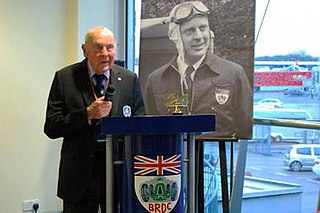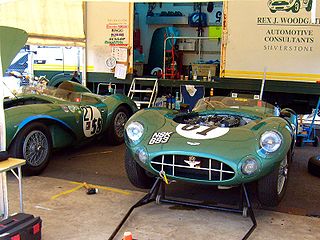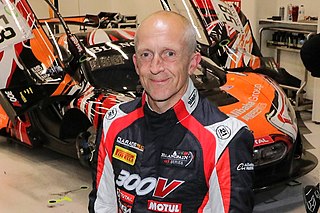Gerald Dallas Royston Marshall was a British racing driver. He was commonly referred to by the nickname Big Gerry. According to a 2002 edition of Motor Sport Magazine poll, he was one of the best drivers of all time. According to the 28 August 2019 edition of Motorsport News, he is the United Kingdom's number one British motorsport hero. He was awarded the BARC Gold Medal in 2002, the first saloon car driver to be presented with the honour and was a life member of the prestigious BRDC. He took 625 overall and class wins and countless championship wins throughout his motor racing career.

Silverstone Circuit is a motor racing circuit in England, near the Northamptonshire villages of Towcester, Silverstone and Whittlebury. It is the home of the British Grand Prix, which it first hosted as the 1948 British Grand Prix. The 1950 British Grand Prix at Silverstone was the first race in the newly created World Championship of Drivers. The race rotated between Silverstone, Aintree and Brands Hatch from 1955 to 1986, but settled permanently at the Silverstone track in 1987. The circuit also hosts the British round of the MotoGP series.

The Aston Martin DB4 GT Zagato is a grand tourer sports car designed by Zagato and produced between 1960 and 1963. Introduced in October 1960 at the London Motor Show, it was effectively a DB4 GT, lightened and improved by the Zagato factory in Italy, by Ercole Spada. Initially, the factory planned to produce 25 cars, but demand was not as strong as expected and production was reduced to 20.

The Aston Martin DB3S is a sports racing car that was built by Aston Martin. Following the failure of the heavy and uncompetitive Aston Martin DB3 designed by Eberan Eberhorst; William Watson, employed as Eberhorst's assistant, presented an alternative design to John Wyer, Aston Martin's competitions manager, whose assistance was needed as Eberhorst could well oppose being up-staged. In total 31 cars were made, with 11 works cars and 20 cars being sold for customer use.

Eric David Thompson was a British racing driver, book dealer and insurance broker. He participated in sports car racing between 1949 and 1955 taking his greatest success by finishing third in the 1951 Les 24 Heures du Mans and took part in the 1952 RAC British Grand Prix.

The 1963 24 Hours of Le Mans was the 31st Grand Prix of Endurance in the 24 Hours of Le Mans series and took place on 15 and 16 June 1963. It was also the tenth round of the 1963 World Sportscar Championship season.

The 1961 24 Hours of Le Mans was a motor race for Sports cars and Grand Touring cars staged at the Circuit de la Sarthe, Le Mans, France on 10 and 11 June 1961. It was the 29th Grand Prix of Endurance and the fourth race of the 1961 World Sportscar Championship. Ferrari and Maserati were the main contenders, with Aston Martin an outside chance.

The Aston Martin DBR1 is a sports racing car built by Aston Martin starting in 1956, intended for the World Sportscar Championship as well as non-championship sportscar races at the time. It is most famous as the victor of the 1959 24 Hours of Le Mans, Aston Martin's only outright victory at the endurance classic. It is one of only three cars in the 1950s to win both the World Sports Car Championship and Le Mans 24 Hours in the same year. In addition the six World Sports Car Championship victories was a record for any car in the 1950s and remained a record in the championship until surpassed by the Ferrari 250TR. The three consecutive triumphs in 1959 at the Nürburgring, Le Mans and the Tourist Trophy equalled the record set by the Ferrari 250TR with its three consecutive victories at the start of the 1958 season.

The Aston Martin DBR2 was a sports racing car built in 1957 as a sibling to the Aston Martin DBR1, yet competing in a larger engine capacity group.

The Aston Martin DP214 was a prototype sports car developed by Aston Martin for use in grand touring-style racing, including the 24 Hours of Le Mans. Two DP214s were built in 1963, with one surviving today.

The Aston Martin DP215 is a prototype sports car built by Aston Martin for grand touring-style racing in 1963. It was built alongside the similar DP214, both of which replaced the previous DP212. Only a single example was built, which survives today.

Motorsport is a popular sport in the United Kingdom. The United Kingdom is a key player in the world of motorsport, hosting rounds of the Formula One World Championship and Grand Prix motorcycle racing, amongst others. It is also the home of many of the current teams in Formula One, such as McLaren, Williams and Aston Martin, while teams such as Red Bull Racing, Mercedes, Alpine and Haas are also based in England. There are also a range of popular national series held such as the British Touring Car Championship and the British GT Championship amongst others. The Motor Sports Association is the official governing body of motorsport in the United Kingdom.

The Nimrod NRA/C2 was the only Group C racing car ever built by Nimrod Racing Automobiles in partnership with Aston Martin. It ran initially in 1982 in the World Endurance Championship before also joining the IMSA GT Championship. The final NRA/C2 would be retired in 1984 after the planned NRA/C3 replacement had been cancelled, and the company went bankrupt.
Robert Geoffrey Verdon-Roe is a British racing driver who has raced in various formats of motor sport throughout his career. He has won Formula Renault, TVR Tuscan and Historic Formula One Championships.

Stephen Christopher Goodwin is a British auto racing driver. Currently he works as Expert High Performance Test Driver for Aston Martin. Additionally he manages the racing career of Bruno Senna and continues to race in International GT Endurance events. He was also TV commentator on F1 for ESPN Star Sports for nearly ten years and occasionally still appears on EPS&M and other networks such as ITV.

The Aston Martin RHAM/1 was a highly modified Aston Martin DBS V8 racing car, developed by Robin Hamilton, built with the intention of racing at the 24 Hours of Le Mans. After development by Hamilton, RHAM/1 competed in the 1977 and 1979 24 Hours of Le Mans, finishing 17th overall and 3rd in the GTP class in the 1977 race. The car has also held the World Land Speed Record, for towing a caravan, at the speed of 124.91 mph.

Jonathan Cocker is a British racing driver. In 2012 he won the ELMS GTE Pro Championship. He competed in the American Le Mans Series (ALMS) for Drayson Racing, a team run by Paul Drayson.

The Aston Martin V12 Zagato is a British sports car/endurance racer made by Aston Martin in collaboration with Zagato to celebrate a fifty-year partnership since the Aston Martin DB4 GT Zagato. Introduced in Lake Como, Italy at the Concorso d'Eleganza Villa d'Este on 21 May 2011, the Zagato was awarded with the competition's "Design Award for Concept Cars and Prototypes" which has also been won by the One-77 in 2009. Zagato introduced the "Corsa" (race) version of the car in 2011 and the "Stradale" (road) version in 2012. The Stradale version doesn't have the black quick releases on the bonnet and boot that the Corsa has and the exhaust pipes of the Stradale version are further apart than on the Corsa version.
Michael Thomas Salmon was a British racing driver from England who competed in the 24 Hours of Le Mans between 1962 and 1984. He was also active in the British Saloon Car Championship and the World and European Endurance championships.
Peter James Scott Lumsden, CBE was a British motorsport competitor who gained renown between 1959 and 1965 racing at Le Mans, the Nürburgring, Silverstone & Goodwood before twice winning at Brands Hatch in his final season in 1965. He is the younger son of Lieutenant-General Herbert Lumsden and brother of Michael.
















